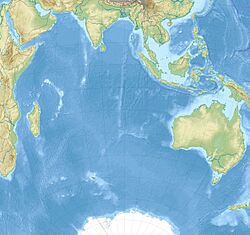Burckle Crater facts for kids
|
Location of Burckle Crater in the Indian Ocean
|
|
| Impact crater/structure | |
|---|---|
| Confidence | Hypothesized, contested |
| Diameter | ~29 km (18 mi; 16 nmi) |
| Depth | 3,800 m (12,500 ft) |
| Age | ~5000 years (Holocene) |
| Exposed | No |
| Drilled | No |
| Bolide type | Unknown, possibly remains of a comet |
| Location | |
| Coordinates | 30°51′54″S 61°21′54″E / 30.865°S 61.365°E |
The Burckle crater is a huge, round shape found deep under the Indian Ocean. It's about 29 kilometers (18 miles) wide. Some scientists think it's a crater made by something hitting Earth from space. This idea comes from a group called the Holocene Impact Working Group. But other geologists aren't so sure about their claims.
Contents
Where is the Burckle Crater?
The Burckle Crater is located about 3,800 meters (12,500 feet) below the ocean surface. That's really far down! It's in the southern part of the Indian Ocean.
You can find it east of Madagascar and west of Western Australia. It's also near a huge underwater mountain range. This range is known as the Southwest Indian Ridge.
The Idea of a Giant Wave Impact
In 2006, the Holocene Impact Working Group suggested that Burckle Crater was formed by an impact event. This means something big, like a comet, hit the Earth. They thought this impact caused a "megatsunami." A megatsunami is a super-giant tsunami wave.
How Scientists Found the Crater
The scientists looked at special dune formations on land. These dunes are shaped like arrows or "chevrons." They are found in Australia and Madagascar. The group believed these chevron dunes were created by a huge tsunami.
By studying where these dunes were, they tried to figure out where the tsunami started. They used a method called triangulation. This helped them point to the location of the Burckle Crater.
Why Some Scientists Disagree
In 2009, other geologists like Jody Bourgeois and R. Weiss questioned this idea. They used computer models to see how a tsunami would behave. They found that the chevron shapes might not be from a tsunami at all.
Instead, they suggested the shapes were made by wind. This process is called aeolian processes. Other scientists also agree that wind, not a tsunami, likely formed these chevrons.
Other Problems with the Impact Idea
There are several reasons why many scientists doubt the Burckle Crater impact claim:
- Rare Impacts: The Holocene Impact Working Group thinks many big impacts happened recently. But astronomical models show that impacts causing huge tsunamis are very rare. They should only happen about once every 100,000 years. So, the group's claims would need very strong proof.
- Wind-Made Dunes: The Working Group says the "chevrons" are from tsunamis. But other geologists had already said these were just parabolic sand dunes. These are common sand dunes made by wind. The chevrons in Madagascar line up perfectly with the usual wind direction there. This suggests wind, not a giant wave, made them over time.
- Melted Rocks Problem: The Working Group reported finding tiny bits of nickel and iron stuck to tiny sea creature shells. They thought these bits were from the impact. But these shells are made of calcium carbonate. This material breaks down at much lower temperatures than nickel and iron melt. It's hard for the shells to survive the heat needed to melt those metals. Also, similar melted bits haven't been found near other known impact craters, like the Chicxulub crater in Mexico.
- Mistakes in the Past: Sometimes, scientists have mistakenly identified natural holes as impact craters. For example, a sheep watering hole in Italy was once thought to be a crater. It was called the "Sirente crater." This shows that finding a hole doesn't always mean an impact happened.
See also
- Fenambosy Chevron
- Flood myth
- List of possible impact structures on Earth
- Mahuika crater
- Umm al Binni structure


